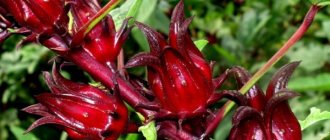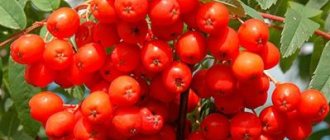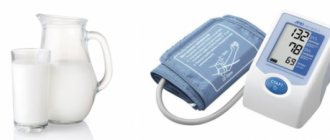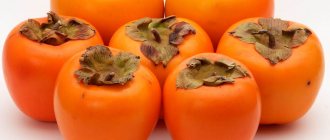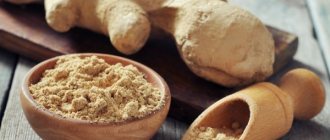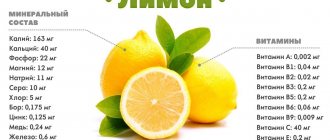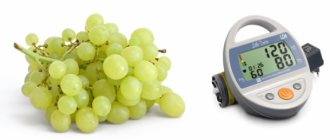The pace of modern life increasingly influences the tone of the human cardiovascular system, causing surges in blood pressure not only in older people, but also in very young people. It is very important to keep this indicator normal, since the consequences of inattention to oneself can be quite severe: stroke or mini-stroke, heart failure, kidney problems.
While following all the recommendations of your doctor, you should not forget about a healthy lifestyle, including in your diet the gifts of nature intended for strengthening and healing. One of these wonderful and healing remedies is the well-known viburnum: a beautiful shrub with clusters of shiny red berries that have a tart-bitter taste.
Pharmacological properties
Since ancient times, berries, bark, leaves, flowers and even seeds of this plant have been used for medicinal purposes.
Viburnum fruits have a rich composition:
- 6 acids (ascorbic, chlorogenic, neochlorogenic, caffeic, ursolic, isovaleric);
- carotenoids and flavonoids;
- atocyanins and sugars;
- vitamins P, C, A;
- tannins and pectins;
- amino acids and sitosterol;
- potassium salts.
This set of biologically active substances allows the plant to be used for medicinal purposes in the pharmacotherapeutic group of diaphoretic and anti-inflammatory drugs.
Viburnum berries:
- increase contraction of the heart muscle;
- normalize pulse;
- have a diuretic effect;
- used as an antipyretic for colds and an expectorant for coughs;
- a general tonic for vitamin deficiencies (they are used in vitamin preparations);
- cleansing (remove toxins and reduce cholesterol levels).
Fruits and bark:
- have a calming effect on the central and peripheral nervous system;
- are excellent antispasmodics;
- used as a tonic;
- activate lipid-fat metabolism;
- Due to its astringent property, it promotes wound healing and reduces inflammatory processes in the gastrointestinal tract.
The bark is:
- a drug that enhances uterine contractility;
- an integral part of the collection, which has a hemostatic and vasoconstrictor effect.
It is also used to prevent infectious and allergic reactions for diseases of the skin (decoctions are applied in the form of lotions, bathing children with pseudofurunculosis, in the form of applications for psoriasis).
An infusion of inflorescences (five and ten percent) resists pathogenic microflora and viruses. Particularly sensitive to it:
- sarcina;
- lemon yellow staphylococcus;
- false anthrax bacillus.
Flowers and leaves in the form of decoctions are used to rinse for diseases of the upper respiratory tract.
Viburnum seeds have a tonic and activate lipid-fat metabolism, so they are used as a coffee substitute.
Peculiarities
Viburnum berries, which have a very specific taste, are actively used for folk healing. The fruits contain fructose, glucose, fatty oils, vitamins A, C, E and P, microelements: phosphorus, manganese, potassium, magnesium, copper, iodine, iron and many others. In addition, berries are a source of tannins, phylloquinones, and saponins.
Due to its rich natural composition, viburnum is used for:
- relieving the inflammatory process;
- decrease in body temperature;
- improving blood circulation;
- relieve tension and calm the nervous system;
- prevention and treatment of seizures;
- normalization of the functioning of the digestive tract;
- stimulation of sputum discharge;
- improved sweating;
- treatment of dermatological pathologies;
- prevention of cancer;
- relieving spasm and pain.
In addition to medicine, the fruits and branches of the tree are used for cosmetic purposes to care for the skin of the face, hands, feet, body, and are used to prepare hair masks.
Application for normalization of blood pressure
Tasty and healthy “medicines” from viburnum, having a wide spectrum of action, have a beneficial effect on the cardiovascular system , normalizing blood pressure . However, it should be taken into account that blood pressure readings can be either low (hypotension) or higher than normal (hypertension). Let's figure out what effect the berry has?
Does viburnum increase or decrease blood pressure?
The answer to this question lies in the effect of essential oils present in the berries. The fact is that these oils produce a diuretic effect. As a result of the removal of fluids from the human body, blood pressure drops.
When treating hypertensive patients, it is not necessary to use only the fruits of the bush - viburnum bark has similar properties.
In what cases is use contraindicated?
In moderate doses, viburnum berries act harmlessly without causing any negative effects. However, it is necessary to use medicinal viburnum potions with great caution:
- people with increased blood clotting and a tendency to form blood clots;
- pregnant women (bark decoctions are strictly prohibited from taking, as they can cause miscarriage or premature birth);
- during lactation;
- those suffering from acute inflammatory processes of the stomach and intestines, especially in the case of gastritis with high acidity;
- at reduced pressure.
And also read on our website: How rose hips affect blood pressure - increases or decreases it, as well as beneficial properties and treatment for hypertension.
In some cases, red fruits can cause allergic reactions due to individual intolerance.
Chemical composition of viburnum, daily requirement per 100 g of fruit
Vitamins
- thiamine (B1) 0.9%;
- riboflavin (B2) 1.1%;
- pantothenic acid (B5) 6%;
- pyridoxine (B6) 3.6%;
- folic acid (B9) 7.5%;
- ascorbic acid (C) 119%;
- alpha tocopherol (E) 13%;
- nicotinic acid (PP) 4.1%;
- phylloquinone (K) 83%;
- beta-carotene (provitamin A) 38%.
Macro- and microelements
- potassium 3.8%;
- calcium 3.7%;
- magnesium 4%;
- sulfur 1.2%;
- phosphorus 12.5%;
- boron 457%;
- vanadium 18.8%;
- iron 40%;
- iodine 60%;
- cobalt 285%;
- lithium 3%;
- manganese 30%;
- copper 6%;
- molybdenum 354%;
- nickel 11%;
- rubidium 3.4%;
- lead 93%;
- selenium 16%;
- silver 1.1%;
- thallium 2.5%;
- chromium 1%;
- zinc 4.2%.
Proteins and amino acids
- proteins 0.5%;
- essential amino acids 1.2%;
- nonessential amino acids 1.1%;
Fats and fatty acids
- fats 1.5%;
- unsaturated fatty acids 2.2%;
- omega-3 - 1.1%;
- omega-6 - 5.2%;
- saturated fatty acids 0.1%.
- Phytosterols 34%.
- Carbohydrates 2.6%.
- Purine bases 6.7%.
Important! It is necessary to know what biologically active compounds differ between different parts of the bush.
The fruits, bark, leaves, and inflorescences of viburnum are differentiated by composition and medicinal use. Viburnum berries contain many organic acids, including valeric acid. They are saturated with various plant compounds: pectins, tannins, resin-like esters, glycosides (viburnin is the most important). Contain compounds of iodine, chromium, phosphorus, manganese, zinc, selenium, iron, copper.
They have a high concentration of vitamins (vitamin K, tocopherol, beta-carotene). Viburnum products are superior to raspberries in the content of ascorbic acid - 2 times, sugar - 3 times, iron - 1.5 times. The bark also has high pharmacological value, as it includes tannins (phlobafen) and resin-like compounds, glycosides and phytosterols.
It has a unique set of organic and fatty acids: caprylic, linoleic, palmitic, butyric, cerotinic, acetic. The leaves are in demand due to their steroids, saponin, ascorbic acid, salicin, and tannins.
Important! Official medicine, along with folk medicine, increasingly prescribes viburnum as an addition to the main course of treatment for hypertension.
Normalize blood pressure using red berries
How to prepare berries for treatment of high blood pressure?
Procurement for storage
Viburnum berries turn red already at the end of August - beginning of September, but they are not yet ready for picking at this time. The fruits at this time have a tart, bitter taste and have an astringent aftertaste. It is recommended to pick them only after the first frost has struck. “Frozen” berries lose their bitterness, they acquire a pleasant sweetness and delicate softness.
To collect berries you need a special approach:
- dry weather outside (to prevent rapid spoilage, which is possible during further storage of wet fruits);
- carefully cutting the berries along with the tassels (so that they fall off less);
- carefully fold into a dry, clean container.
Proper storage involves several methods.
| № | Way | What do we have to do |
| 1. | Fresh |
|
| 2. | Freezing |
|
| 3. | Drying |
|
Tea
There are several simple recipes for preparing this surprisingly pleasant drink. Here are some of them.
- Viburnum tea based on green tea. To do this, you need to brew your favorite green tea in the usual way. Add to it separately washed and mashed viburnum berries (2 tablespoons). Let the drug brew for ten minutes. Enjoy excellent taste properties (and also lower your pressure levels down several positions ).
- Tea drink made from viburnum. Place 2-3 tablespoons of berries in a cup, add sugar to taste, grind the fruits so that they release juice. Pour a glass of boiling water. Let it brew for a minute or two and drink the aromatic drink with pleasure.
And also read on our website: How does propolis affect blood pressure: does it increase or decrease?
Tinctures
In order to prepare a medicinal product from viburnum based on “classic alcohol”, two main ingredients are needed:
- viburnum (berries) - 1.5 kg;
- vodka - 1.5 l.
Ten-step cooking technology:
- We carefully sort the berries, removing small twigs and stuck leaves.
- We rinse several times in a container with water, finishing with a “shower” of running water.
- Dry on a clean napkin or cotton towel.
- Transfer the viburnum to a glass container, filling it halfway.
- Pour vodka so that it completely covers the red fruits.
- Close the container with a tight-fitting lid.
- Place in a warm place.
- After 24 hours, take out the viburnum tincture and pour in the rest of the alcohol.
- We return the container to its original place, where it will infuse for another month.
- After the specified period, filter the drink and the tincture is ready for use.
Self-prepared viburnum tincture with vodka should be taken at high blood pressure three times a day before meals, a tablespoon in half a glass of water for 3-4 weeks until the condition improves.
Recipe with honey
To prepare this remedy, do this:
- We sort out 2 kg of viburnum.
- Wash and dry the berries.
- Place the prepared raw materials in a large jar.
- Add half a liter of good cognac.
- Add half a kilogram of natural honey.
- Pour in 1.5 liters of boiled chilled water.
- Close with a tight lid.
- Place in a cool, dark place.
- After 1.5 months, the drink is filtered and bottled.
To normalize blood pressure levels, we take 1 tablespoon during meals three times a day. The drink also has a general strengthening tonic effect, relieves spasms, eliminates headaches, reduces swelling in case of kidney and heart disorders, improves digestion in case of gastritis with low acidity.
A drink prepared in this way has a long shelf life, since honey and cognac are excellent preservatives.
We talked about viburnum tincture with the addition of honey, but this useful ingredient can be added to viburnum tea, making it even more healing. Please note that viburnum with honey in the second option can be given even to small children, as well as adolescents during age-related surges in blood pressure (with a tendency to increase it).
And also read on our website about St. John's wort and green tea to stabilize blood pressure?
How to take viburnum?
It is important to know!
STILL STRUGGLE WITH ARTERIAL HYPERTENSION INCORRECTLY? The first bioavailable drug with proven effectiveness Read more »
In order for viburnum to give only positive properties, you need to learn how to take it correctly, following all methods and dosages. The berries can be taken in almost any form, but in order for the body to receive as many useful substances as possible, it is best to simply absorb them without processing the viburnum. If this method is not convenient for use, you can prepare special tinctures based on alcohol or tea. You need to take teas in small dosages and as a preventive measure for attacks. In advanced stages and during a hypertensive crisis, it will not be appropriate.
The most effective and efficient way is to eat fresh viburnum fruits with honey. They will help normalize blood pressure and relieve you of unpleasant symptoms during hypertension. In addition, viburnum with honey is an excellent remedy that helps strengthen the body, relieve a person from stressful situations, and relieve all fatigue, which is an excellent option for well-being.
The use of viburnum is not always appropriate; there are situations in which its use is considered prohibited. One of them is breastfeeding.
The use of the medicine in this case should be carried out according to the following rules:
- During breastfeeding, blood pressure can also increase, and in order to normalize it, it is recommended to gradually introduce viburnum berries into your diet, combining them with fruit juice or compote, so as not to cause a sharp reaction in the baby.
- You can drink up to 200 ml of viburnum-based liquid per day.
- If within 24 hours after taking the product the baby does not experience any allergies, you can safely add it to your diet.
- It is best to make teas from viburnum; it is not recommended to take it fresh.
Reviews
Expert opinion
Lyudmila
Site reader
I often drink tea with viburnum. I really like its smell and bitter aftertaste. I have known about the benefits of viburnum tea for a long time; I try to consume it during the winter cold to prevent colds. The pressure remains normal.
Expert opinion
Tamara
Site reader
I drink tea with viburnum berries. It invigorates well and raises vitality. Blood pressure is always ideal. Sometimes I brew viburnum itself, but sometimes I alternate it with tea made from currant leaves. By the way, I use the juice and pulp for masks to remove oily skin and lighten freckles.
Expert opinion
Svetlana
Site reader
Since childhood, I remember how viburnum bushes were planted in many neighbors’ yards. They were always pleasing to the eye, and the round red berries helped to cope with colds, coughs, and burning in the throat. I didn’t know that viburnum lowers blood pressure until I read it in the newspaper. I drink a spoonful of alcohol tincture before bed. My blood pressure returned to normal and my sleep became stronger.
Expert opinion
Basil
Reader
I think that it is not at all necessary to immediately run to the pharmacy and pick up a bunch of pills. Now, if in the initial stages of hypertension people were more attentive to their health, there would not be these cosmic pressure surges. Viburnum, valerian and morning exercises are my three companions in the treatment of hypertension.
Expert opinion
Galina
Site reader
Fearing dependence on pills, I give my child only medicinal teas. In our family, hypertension is hereditary. My grandfather began to suffer from pressure changes early on, and my aunt always suffered from headaches. During the entrance exams, due to stress, my teenage son also “jumped.” I hope viburnum will help him calm down and normalize his condition.
